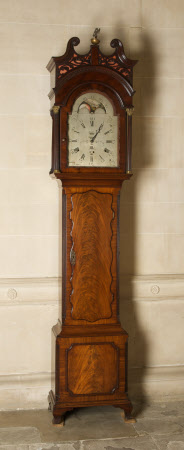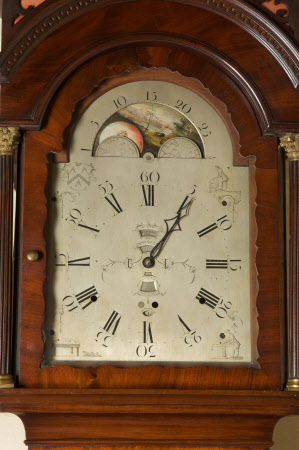Longcase clock
Category
Horology
Date
1700 - 1799
Materials
Mahogany wood, steel, metal, lead and nylon.
Order this imageCollection
Lacock, Wiltshire
NT 995904
Summary
Large eighteenth century mahogany musical longcase clock with swan neck pediment, Corinthian columns and figured mahogany door and canted and reeded corners. Silvered brass, break-arch dial with painted moonphase in the arch, Roman hour numerals, Arabic 5-minute interval markers, blued steel hands and engraved corner decorations depicting the heraldry of the Worshipful Company of Carpenters and three images of woodworking craftsmen and their tools.
Full description
Large eighteenth century mahogany musical longcase clock with swan neck pediment, Corinthian columns and figured mahogany door and canted and reeded corners. Silvered brass, break-arch dial with painted moonphase in the arch, Roman hour numerals, Arabic 5-minute interval markers, blued steel hands and engraved corner decorations depicting the heraldry of the Worshipful Company of Carpenters and three images of woodworking craftsmen and their tools. There is an engraved month disc behind the dial which is indexed every month by the calendar wheel. The disc displays the month (with its number of days in Roman numerals) and associated sunrise, daybreak, sunset, sun’s position in the zodiac, and holy days through apertures arranged around the centre of the dial. The date is indicated by the calendar wheel through an eye-shaped aperture above the 6 o’clock position. The movement has wooden plates with rolled brass bearings, brass wheels mounted to wooden arbors and steel lantern pinions. The going train is regulated by a strip-pallet anchor recoil escapement. The striking train is regulated by a countwheel and strikes the hours on two bells simultaneously. The countwheel has pins to unlock the musical train after the hours of 3, 6, 9 and 12 have been struck. The musical train has a large wooden carillon (wrapped in paper with steel pins) and 19-pipe organ section, driven by a large lead weight. The left hand winding hole is empty, the musical train is wound from the side of the clock (the hood has to be removed for this due to poor design position of the side door), where a shut off lever can also be accessed to prevent the music from playing at all.
Provenance
Purchased with the family collection of Abbey contents in situ from Mrs Petronella Burnett-Brown December 2009.

